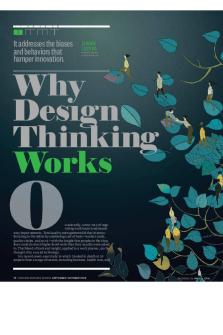Worksheet 1: Design Thinking PDF

| Title | Worksheet 1: Design Thinking |
|---|---|
| Author | Alana Roberts |
| Course | Design Thinking Practices |
| Institution | Auckland University of Technology |
| Pages | 2 |
| File Size | 93.1 KB |
| File Type | |
| Total Downloads | 40 |
| Total Views | 158 |
Summary
Semester 2, 2019
Lecturer: Anna Jackson
Workbook 1: assigned questions based on in-class activities and readings...
Description
Worksheet One: (5 Marks) The reading for Worksheet One is an article by Tim Brown, CEO of IDEO, an international design firm known for its use of Design Thinking. In this article, Brown explains the core principles of Design Thinking and shares real-world examples of how Design Thinking can be used to improve products, processes, services and experiences. Brown also discusses the personal characteristic of Design Thinkers. Brown, T. (2008). Design Thinking. Harvard Business Review, 86(6), 84–92. Retrieved from http://search.ebscohost.com.ezproxy.aut.ac.nz/login.aspx? direct=true&db=bth&AN=32108052&site=eds-live (you can access this reading via Course Resources on Blackboard) For each question below, you should write a full paragraph (at least 100 words)
1) Brown describes design thinking as a human-centred approach. What do you think this means? Try to give an example or provide a detailed description that supports your explanation.
Design-thinking is a human-centred approach as it involves understanding the consumer and their environment to develop meaningful solutions that respond to actual needs. Design-thinking enables the designer to get to the core of the consumer need and create a solution that addresses more than the surface level of the problem. For example, when designing a wallet for a consumer, the designer uncovered that the consumer's previous wallet had been stolen. Identifying the consumer's issue with security dramatically changed how the designer approached the creation of a new wallet. This process shows how having a human-centred approach results in the realisation that the problem we thought we were facing is not the 'real' problem. 2) What (according to Brown) is the role of prototyping in the design process? Describe in your own words.
Brown describes the role of prototyping as an opportunity to receive feedback, which is necessary for the further development of a product or idea. Prototyping is used to assess the strengths and weaknesses of an idea and use this information to innovate further. It gives consumers the ability to physically see what the product is and can do, and therefore comment on new directions the design could take. The prototype is not a finished or final product, it is a design intended to showcase the idea and therefore, leave room for suggestions and improvements.
3) Choose one of the characteristics of design thinkers that Brown identifies (‘A Design Thinker’s Personality Profile, p. 87) and give an example of how you have applied this characteristic in a specific situation in your own life:
The design thinking characteristic of optimism is displayed by people who are able to find a positive angle in any situation. Optimism is demonstrated in the belief that in any given problem, the implementation of at least one solution makes an improvement to the existing environment. I have applied optimism when offering advice to a friend in a tough financial position. With a low paying job, expensive living costs and busy social life, my friend had no hope that she would ever reach financial stability. However, I remained optimistic and evaluated the situation to find small, easily implemented solutions that would still make a difference to her finances. 4) In class in week 1 you undertook the Design Thinking challenge of redesigning your partner’s routine. What was the most surprising, interesting or challenging aspect of this activity for you (and why)?
I found it challenging to not force my own morning routine, what I think is the most efficient way to do things, onto my partner. When empathising with the person you are designing for, it is hard to not compare their problems with your own life. It is very easy to look for similarities between two situations, to be able to apply existing knowledge and solutions. Therefore, I challenged myself to extend my thinking and suggest alternatives that were different from my morning routine. It was important to engage in listening to my partner to better understand their unique point-of-view, without searching for information that I had personally experienced....
Similar Free PDFs

Worksheet 1: Design Thinking
- 2 Pages

Design Thinking
- 11 Pages

Worksheet @1 - Loads Design
- 6 Pages

Laporan DESIGN THINKING
- 24 Pages

Design thinking workshop
- 5 Pages

Design Thinking Proposal
- 4 Pages

TB1 Design Thinking - TB1
- 9 Pages

Manual design thinking
- 48 Pages

Tim Brown, Design Thinking
- 11 Pages

Why Design Thinking Works
- 9 Pages

Tim Brown, Design Thinking
- 11 Pages

Caso Práctico Design Thinking
- 1 Pages
Popular Institutions
- Tinajero National High School - Annex
- Politeknik Caltex Riau
- Yokohama City University
- SGT University
- University of Al-Qadisiyah
- Divine Word College of Vigan
- Techniek College Rotterdam
- Universidade de Santiago
- Universiti Teknologi MARA Cawangan Johor Kampus Pasir Gudang
- Poltekkes Kemenkes Yogyakarta
- Baguio City National High School
- Colegio san marcos
- preparatoria uno
- Centro de Bachillerato Tecnológico Industrial y de Servicios No. 107
- Dalian Maritime University
- Quang Trung Secondary School
- Colegio Tecnológico en Informática
- Corporación Regional de Educación Superior
- Grupo CEDVA
- Dar Al Uloom University
- Centro de Estudios Preuniversitarios de la Universidad Nacional de Ingeniería
- 上智大学
- Aakash International School, Nuna Majara
- San Felipe Neri Catholic School
- Kang Chiao International School - New Taipei City
- Misamis Occidental National High School
- Institución Educativa Escuela Normal Juan Ladrilleros
- Kolehiyo ng Pantukan
- Batanes State College
- Instituto Continental
- Sekolah Menengah Kejuruan Kesehatan Kaltara (Tarakan)
- Colegio de La Inmaculada Concepcion - Cebu



